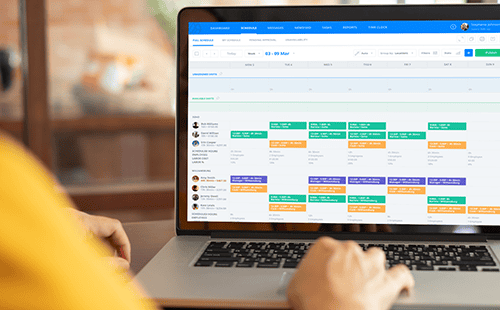How To Calculate And Lower Labor Costs
Labor costs are one of the highest expenses that most businesses contend with. O...

Looking for a way to make it as easy as possible for your team members to remember when they work? Try a fixed schedule.
In this article, you’ll learn what a fixed schedule is, how to implement one in your business, and the advantages and disadvantages that come with it.

A fixed schedule is one in which an employee works set days and set hours for an extended period of time (or permanently).
One of the most common fixed schedules is the standard schedule: Monday through Friday, 8:00 a.m. to 5:00 p.m. with a one-hour lunch break from noon to 1:00 p.m.
As familiar as everyone is with the standard model, it’s not the only option. You could choose a fixed schedule of Tuesday through Saturday from 10:00 a.m. to 7:00 p.m., Monday through Friday from 7:00 a.m. to 4:00 p.m., or any combination that works for your business.
The determining factor is that the schedule doesn’t change from one day, week, or month to the next. Most fixed schedules are always in effect — think of an office environment that works the standard schedule year round.
That being said, you may choose to implement such a roster for any period of time (e.g., a week, a month, three months, etc.) as long as the time worked stays static.

A fixed schedule makes it easier for your team members to plan and schedule their lives off the job.
This can often allow for a better work-life balance and contribute to other intangible benefits, including:
Additionally, if some on your team work remotely, a fixed schedule can help them separate their work life from their personal life more effectively.
When everyone on your team works the same schedule, it becomes much easier for them to collaborate on projects or tasks.
This also makes it easier for managers to coordinate employee activities for maximum success because everyone is in the office (or online) at the same time.
Consistency within the work day and the work week is fundamental to the success of your team. The fixed nature of this type of schedule might allow them to channel more of their energy, not into when they have to work, but into what they’re working on at the time.
When they know that they’re working the same days and times week after week, they may find it easier to focus on team initiatives, company goals, and project deadlines.
A fixed schedule can also benefit the business itself by making it easier to plan for the long term.
With the consistency that comes from your team working the same days and times week after week, you’ll be better able to predict labor costs, number of employees needed, and a whole host of other variables.
For some businesses, simplified management is the most attractive aspect of running a fixed schedule. A fixed schedule can dramatically reduce the time it takes managers (and others in oversight) to coordinate employee activity.
A fixed schedule can also make it much easier for employees to track their time and attendance at the point of recording and for managers to use those numbers to calculate payroll, monitor overtime, and analyze productivity.

If employees can’t find ways to schedule their personal lives outside of regular work hours, tardiness and absenteeism may become an issue.
In most cases, you can fix the problem (or, at least address it) by implementing a company-wide attendance policy that outlines how employees can get time off for important appointments.
For some, the freedom of a flexible schedule may be more enticing than the consistency of a fixed schedule.
Potential new hires may see it as a negative that they have to be at work Monday through Friday from 8:00 a.m. to 5:00 p.m. and may choose not to work for your business because of it.
If one set of employees always works 8:00 a.m. to 4:00 p.m. and another set of employees always works 4:00 p.m. to midnight, your business can become divided along shift lines.
Such divisions can lead to animosity among teams that can be counterproductive for your business.
In some cases, if an employee finishes their work before the shift ends and you don’t have anything else for them to do that day, they may have to stay clocked in while others continue to work.
Normally, you would simply ask that employee to help another employee, but the rigidness of a fixed schedule can be the cause of wasted time within your business.
The operational rigidity inherent in the fixed schedule can make it difficult to adjust staffing levels to meet the needs of your business if (or when) they change.
Examples of times when your business may need to be a bit more flexible with its staffing requirements include peak seasons, slow seasons, holidays, common vacation months, and unexpected changes in demand.

Your business might choose the standard model and schedule team members to work Monday through Friday. Or, your business may choose Monday through Saturday, Wednesday through Sunday, or whatever combination of days works best.
Your business may need 24-hour coverage, 16-hour coverage, 12-hour coverage, 8-hour coverage, or some number in-between.
When making your decision, consider the start and end times that might work best for your team.
If your business needs 24-hour coverage, you’ll likely need to divide the day into three shifts to make it all work (e.g., 8:00 a.m. to 4:00 p.m., 4:00 p.m. to midnight, and midnight to 8:00 a.m.)
If you only need eight hours of coverage, you can probably get by with one shift per day.
If your schedule isn’t permanent, you’ll need to decide how long you want the fixed calendar to last. A month is typically a sufficient amount of time to allow everyone to adapt, but you may choose to go longer or shorter according to business needs.
Once you’ve established the days, hours, shifts, and duration of the fixed schedule, you’re ready to choose the employees who will work each shift.
The final step of implementing a fixed schedule is to roll out the new calendar to your employees.
One of the best ways to do this is with a cloud-based distribution method (like that offered by Sling) that everyone can access on whatever device they choose to use.

If you run a restaurant or other food service operation, a fixed schedule may provide the stability your team needs to perform their jobs better.
If you think this type of timetable would work well for your business, consider trying it for a few weeks or a month to see how things go. If, after a sufficient testing period, it doesn’t seem to be working, you can always go back to the rota you had before.
That said, before you decide on whether the fixed schedule is right for your team or not, be sure to ask for their thoughts (either via survey, team meeting, or one-on-one meeting). After all, they’re the ones this will most affect.

There are many different types of schedules out there. Some are naturally fixed, while others vary from day to day, week to week, month to month, and year to year.
The important thing to understand about all of these schedules is that you can transform them into a fixed variation simply by assigning each employee to a shift that doesn’t change.
So, if employee A works a DuPont schedule (which naturally changes from week to week), you can change it to a fixed DuPont schedule simply by assigning employee A to the day shift (8 a.m. to 8 p.m.) for the foreseeable future.
That means employee A would always work one of the following schedules:
Keep in mind that entire teams can follow a fixed schedule — substitute team A for employee A in the previous example — as long as their work hours and work days don’t change.
You may also choose to create a fixed version of the commonly variable on-call schedule. In most cases, an on-call schedule changes from month to month (or however long a single schedule lasts).
That means employee A will be on call during different days every month (e.g., the first and third Saturday and the second Wednesday in March and the first Sunday and second and third Tuesday in April).
In a fixed on-call schedule, employee A will always be on call during the second and fourth Friday every month while employee B will always be on call during the first and third Monday every month.
Of course, this only works if you have enough employees to cover all the necessary shifts during a given month (and all subsequent months).
If you don’t have enough employees to maintain a static schedule, you may need to go back to the variable schedule so that every shift is covered when it needs to be.
The point is, any schedule can be made to be a fixed schedule by removing any changes to the regular time and day that an employee works.
If you’re thinking about changing from a variable to a fixed schedule, examine what you’ve got in place first before making any big changes.
See if it makes sense to keep the general framework of the variable schedule while transforming it into a fixed schedule by not changing when an employee works from day to day or week to week.
This may require your employees to make some big changes to their lives, but, if everyone is in agreement, it can have dramatic benefits for everyone involved.
The best schedule for your business depends on a number of factors, including the type of business you run, your customer/client needs, your business goals, legal and compliance regulations, and employee availability and preferences.
Type of business: The type of business you run has a major influence on the schedule you choose. For example, a retail establishment would absolutely need to be open when its customer base is out and about (typically from 9 a.m. to 9 p.m.).
An overseas commodities-trading firm, on the other hand, may function at its best with a fixed schedule set at 3 a.m. to 12 p.m.
Customer/client needs: Another key consideration is the needs of your customers and clients.
If peak demand for your business doesn’t occur until after your clients stop work for the day, you may choose to adjust your work schedule to start later in the morning and work later into the evening.
Business goals: Do your best to align the work schedule with the goals you’ve set for the business (e.g., maximizing productivity, reducing costs, improving customer satisfaction).
For example, in order to maximize productivity, you may need to add a night shift after the “9-to-5” fixed schedule that you regularly run.
A great way to see if your scheduling practices are contributing to the overall goal is to track the key performance indicators that apply to your specific situation.
Legal and compliance regulations: When setting up a fixed schedule (or any type of schedule, for that matter), be sure to check all legal and compliance regulations that apply to your business.
There may be specific laws about overtime, maximum hours allowed, breaks, and much more.
Employee availability: Employee availability also plays a big role in determining the type of schedule that’s best for your business. If you can’t get enough team members to cover the shift, it may be better for business if you adjust the schedule or implement a different one altogether.

Whether you choose a fixed schedule for your team or one of the many other types available, you can manage them all with the Sling suite of tools.
Sling can help you simplify even the most complicated schedule with powerful tools, such as:
Try Sling for free and get the resources you need to help you manage your business better, organize and schedule your team, and track and calculate labor costs.
See Here For Last Updated Dates: Link
This content is for informational purposes and is not intended as legal, tax, HR, or any other professional advice. Please contact an attorney or other professional for specific advice.
For businesses that have multiple shifts, a fixed shift schedule is one that does not have employees rotating through different work hours.
So, for example, if your business has three shifts, employee A would always work the first shift, employee B would always work the second shift, and employee C would always work the third shift.
That is in contrast to some shift schedules that change from week to week or month to month so that employee A may work the first shift for seven days, the second shift for seven days, and the third shift for seven days (with employees B and C changing shifts as well).
The most common fixed schedule is the “9-to-5” time slot. This schedule is a leftover from the latter half of the 20th century when many office-based employees worked those hours.
Though times have changed and few businesses actually work 9 a.m. to 5 p.m. anymore, the name has become synonymous with the day shift — whatever that may be for your business.
Some 9-to-5 schedules run from 8 a.m. to noon and 1 p.m. to 5 p.m. with an unpaid hour break for lunch. Other 9-to-5 schedules run from 10 a.m. to 6 p.m. with a paid break in the middle where employees still have to be “on call” for any customers that walk in or call.
Schedule faster, communicate better, get things done.